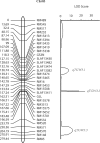Rapid identification of major QTLs associated with rice grain weight and their utilization
- PMID: 25815721
- PMCID: PMC4376791
- DOI: 10.1371/journal.pone.0122206
Rapid identification of major QTLs associated with rice grain weight and their utilization
Abstract
To uncover the genetics of rice grain weight, we constructed an RIL population derived from a cross between a large grain accession M201 and a small size variety JY293. Specific Locus Amplified Fragment Sequencing (SLAF-Seq) technology was used to genotype two bulked DNA pools made from individual DNA of the heaviest 30 lines and the lightest 30 lines according to the 1000 grain weight (TGW). Bulked segregant analysis (BSA) was used to identify SLAFs strongly associated with TGW. Two marker-intensive regions at 24,600,000-24,850,000 bp and 25,000,000-25,350,000 bp on chromosome 3 were identified tightly related to the TGW. Then a linkage map of chromosome 3 was constructed with SSR markers and some SLAF derived single nucleotide polymorphisms (SNPs). Quantitative trait locus (QTL) mapping for TGW, grain length, grain width, and grain thickness revealed one major QTL in the second hot-region and two other minor QTLs for grain weight. These three QTLs displayed hierarchical effects on grain length and grain weight in order of qTGW3.2 (qGL3) qTGW3.1 (GS3) qTGW3.3. Multiple comparisons of means among the eight combinations of 3 QTLs revealed that the lines with two of three QTLs deriving from M201 displayed a large grain weight phenotype (TGW 40.2g, average data of three years) and lines with both qTGW3.1 and qTGW3.3 alleles from M201 (42.5g) had similar grain weight to the qTGW3.2 (40.8g) alone. Two strategies with similar effectiveness were proposed to improve grain weight by marker-assisted selection (MAS). One is to introduce the novel qTGW3.2 allele alone, and the other is to pyramid qTGW3.1 and qTGW3.3 alleles together. One new allele of GS3 (39 bp deletion in intron 1) and two SNPs in coding sequence of qGL3 identified in this study from M201 are useful in pyramiding elite alleles for molecular breeding for improvement of rice yield.
Conflict of interest statement
Figures


References
-
- Fan C, Xing Y, Mao H, Lu T, Han B, Xu C, et al. GS3, a major QTL for grain length and weight and minor QTL for grain width and thickness in rice, encodes a putative transmembrane protein. Theor Appl Genet. 2006; 112: 1164–1171. - PubMed
Publication types
MeSH terms
LinkOut - more resources
Full Text Sources
Other Literature Sources

